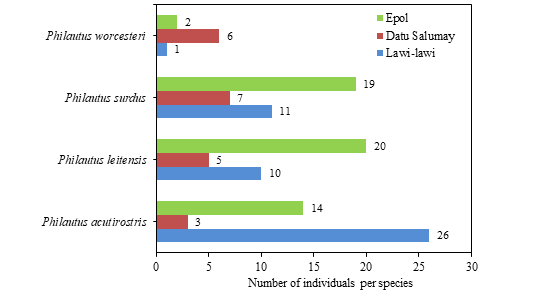Philautus (Bush Frogs) Species from Montane Forest of Marilog District, Davao City, Southern Mindanao, Philippines DOI: 10.32526/ennrj.17.2.2019.13
Main Article Content
Abstract
Despite herpetological surveys conducted in Mindanao, scanty data are known about the Philautus species in montane forests as well as its account in southern Mindanao. Species accounts of Philautus sampled from the montane forest of Marilog District in Southern Mindanao with notes on it microhabitats were provided. Belt-transect sampling and microhabitat searches were employed in three different sites. A total of 124 individuals representing four species of Philautus were accounted, three of which are currently known only from forested areas of Mindanao. Philautus acutirostris is the most encountered species. Thirty-four genera of plants associated with microhabitats of Philautus species were accounted. Although the majority of the frog individuals appear to use the plants for perching, other notable activities were also noticed. Further observations may reveal data that will unravel other significant roles of these associated plants in microhabitats of Philautus species.
Article Details
Published articles are under the copyright of the Environment and Natural Resources Journal effective when the article is accepted for publication thus granting Environment and Natural Resources Journal all rights for the work so that both parties may be protected from the consequences of unauthorized use. Partially or totally publication of an article elsewhere is possible only after the consent from the editors.
References
2. Alcala AC, Bucol A, Diesmos C, Brown RM. Vulnerability of Philippine amphibians to climate change. Philippine Journal of Science 2012;141(1):77-87.
3. Angelini C, Altieri AH, Silliman BR, Bertness MD. Interactions among foundation species and their consequences for community organization, biodiversity, and conservation. BioScience 2011; 61:782-9.
4. Ates F, Delima EM. Assemblage and microhabitats of anurans from Mt. Sinaka, Arakan, Cotabato and Mt. Hamiguitan, Davao Oriental, Mindanao Island, Philippines. Journal of Nature Studies 2008;7(1):101-7.
5. Brown W, Alcala A. Philippine frogs of the family Rhacophoridae. Proceedings of the California Academy of Sciences 1994;48(10):185-220.
6. Brown R, Oliveros C, Siler C, Fernandez J, Welton L, Buenavente PA, Diesmos M, Diesmos A. Amphibians and reptiles of Luzon Island (Philippines) VII: Herpetofauna of Ilocos Norte Province, Northern Cordillera Mountain Range. Checklist 2012;8(3):469-90.
7. Brown R, De Layola L, Lorenzo A, Diesmos M. A new species of limestone karst inhabiting forest frog, genus Platymantis (Amphibia: Anura: Ceratobatrachidae: subgenus Lupacolus) from southern Luzon Island, Philippines. Zootaxa 2015;2:191-210.
8. Bossuyt F, Dubois A. A review of the frog genus Philautus Gistel, 1848 (Amphibia, Anura, Ranidae, Rhacophorinae). Zeylanica 2001;6(1):1-112.
9. Bruno A, Macas D, Buenavista D, Medina M, Forten R. Amphibian and reptile diversity in Mt. Kalatungan Range Natural Park, Philippines. Environmental and Experimental Biology 2017;15:127-35.
10. Dacalus C, Calunsag A, Hoshino L, Peralta D, Baron EM. Anuran assemblage on forest edges of Datu Salumay, Davao City, Philippines. University of Mindanao International Multidisciplinary Research Journal 2017;2(1):1-7.
11. Delima EM, Diesmos A, Ibanez J. The Hertological Importance of Mt. Hamiguitan Range, Mindanao Island, Philippines. Banwa 2007;4(1):27-40.
12. Diesmos A, Brown R, Gee G. International Union for the Conservation of Preliminary Report on the Amphibians and Reptiles of Balbalasang-Balbalan National Park in Luzon Island, Philippines.
13. Sylvatrop: The Technical Journal of Philippine Ecosystems and Natural Resources 2003;13(1-2):63-80.
14. Diesmos A, Alcala A, Siler C, Brown R. Status and conservation of Philippine amphibians. In: Heatwole H, Das I, editors. Conservation Biology of Amphibians of Asia. Status and Decline of Amphibians: Eastern Hemisphere. Kota Kinabalu: Natural History Publications; 2014. p. 310-36.
15. Frost D. Amphibians species of the world: an online reference version 6.0 [Internet]. 2018 [cited 2018 Aug 8]. Available from: http://research.amnh.org/ herpetology/amphibia/index.html.
16. Heyer WR, Donnelly MA, McDiarmid RW, Hayek LAC, Foster MS. Measuring and Monitoring Biological Diversity: Standard Methods for Amphibians. Washington D.C., USA: Smithsonian Institution Press; 1994.
17. Mcleod D, Siler C, Diesmos A, Diesmos M, Garcia V, Arkonceo A, Balaquit K, Uy C, Villaseran M, Yarra E, Brown R. Amphibians and reptiles of Luzon Island V: The Herpetofauna of Angat Dam Watershed, Bulacan Province, Luzon Island, Philippines. Asian Herpetological Research 2011;2(4):177-98.
18. Nuneza O, Ates F, Alicante A. Distribution of endemic and threatened herpetofauna in Mt. Malindang, Mindanao, Philippines. Biodiversity Conservation 2010;19:503-18.
19. Plaza J, Sanguila M. Preliminary report on the anurans of Mount Hilong-Hilong, Agusan del Norte, Eastern Mindanao, Philippines. Asian Herpetological Research 2015;6(1):18-33.
20. Sanguila M, Cobb K, Siler C, Diesmos A, Alcala A, Brown R. The amphibians and reptiles of Mindanao Island, Southern Philippines, II: The herpetofauna of Northeast Mindanao and adjacent islands. ZooKeys 2016;642:1-132.
21. Scheffers B, Phillips B, Shoo L. Asplenium bird’s nest ferns in rainforest canopies are climate contingent refuges for frogs. Global Ecology and Conservation 2014;2:37-46.
22. Supsup C, Guinto F, Redoblado R, Gomez R. Amphibians and reptiles from the Mt. Hamiguitan Range of Eastern Mindanao, Philippines: new distribution records. Checklist 2017;13:1-14.
23. Warguez D, Mondejar E, Demayo C. Frogs and their microhabitat preferences in the agricultural and secondary forest areas in the vicinity of Mt. Kalatungan Mountain, Bukidnon, Philippines. International Research Journal of Biological Sciences 2013;2(10):51-63.
